Health Variations 5: Ethical Dimensions of End-of-Life Care
VerifiedAdded on 2022/08/23
|6
|1767
|18
Essay
AI Summary
This essay delves into the ethical considerations surrounding the end-of-life care for John, a 20-year-old Aboriginal Torres Strait Islander with end-stage renal disease. It explores the complexities of respecting John's autonomy in refusing further treatment, the ethical principles of beneficence, non-maleficence, and justice, and the importance of cultural sensitivity in providing appropriate care. The essay also highlights the role of an interdisciplinary team in navigating these ethical dilemmas and ensuring that John's wishes and cultural background are respected throughout his palliative care journey. The author reflects on personal values and professional ethics in end-of-life care.
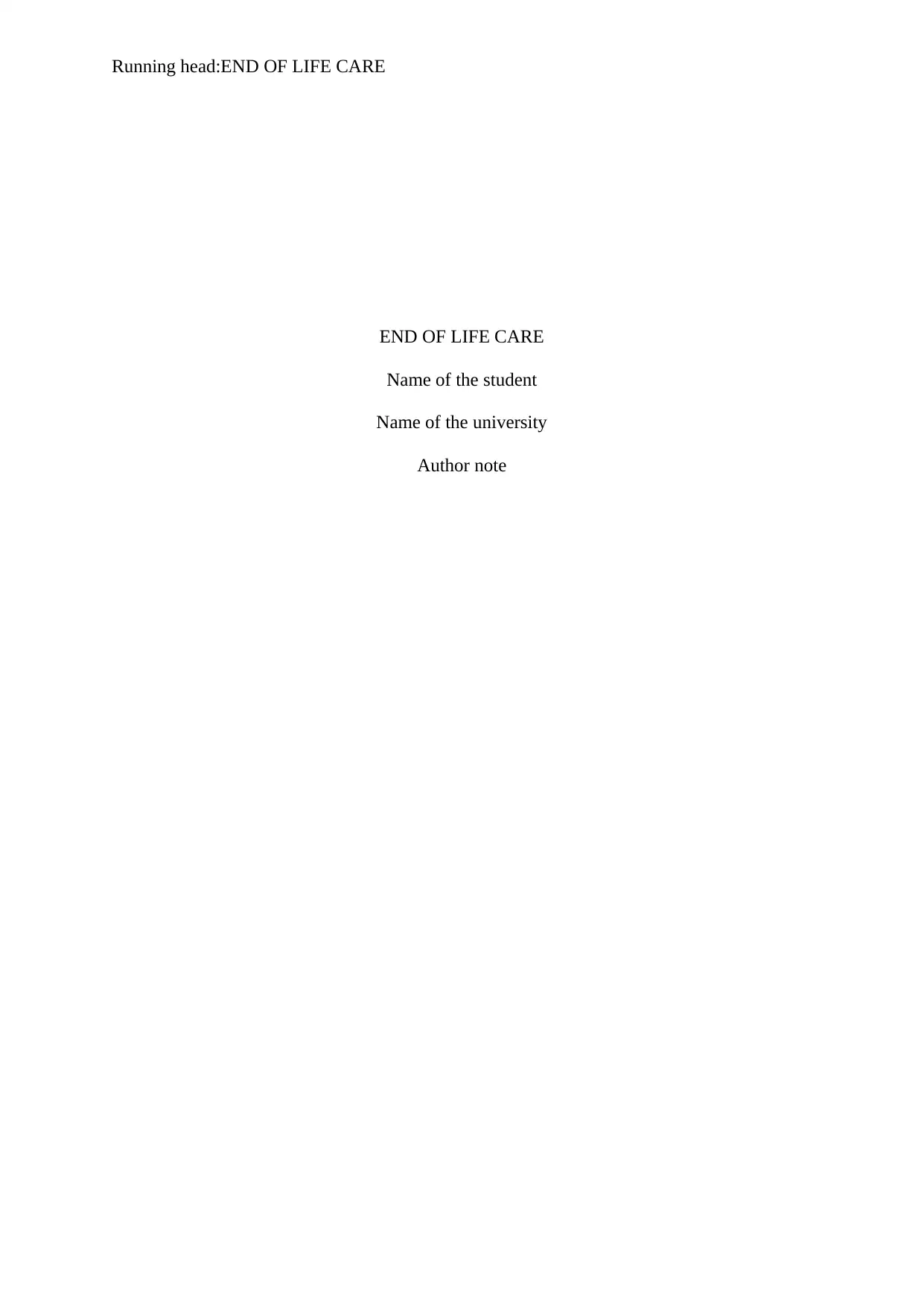
Running head:END OF LIFE CARE
END OF LIFE CARE
Name of the student
Name of the university
Author note
END OF LIFE CARE
Name of the student
Name of the university
Author note
Paraphrase This Document
Need a fresh take? Get an instant paraphrase of this document with our AI Paraphraser
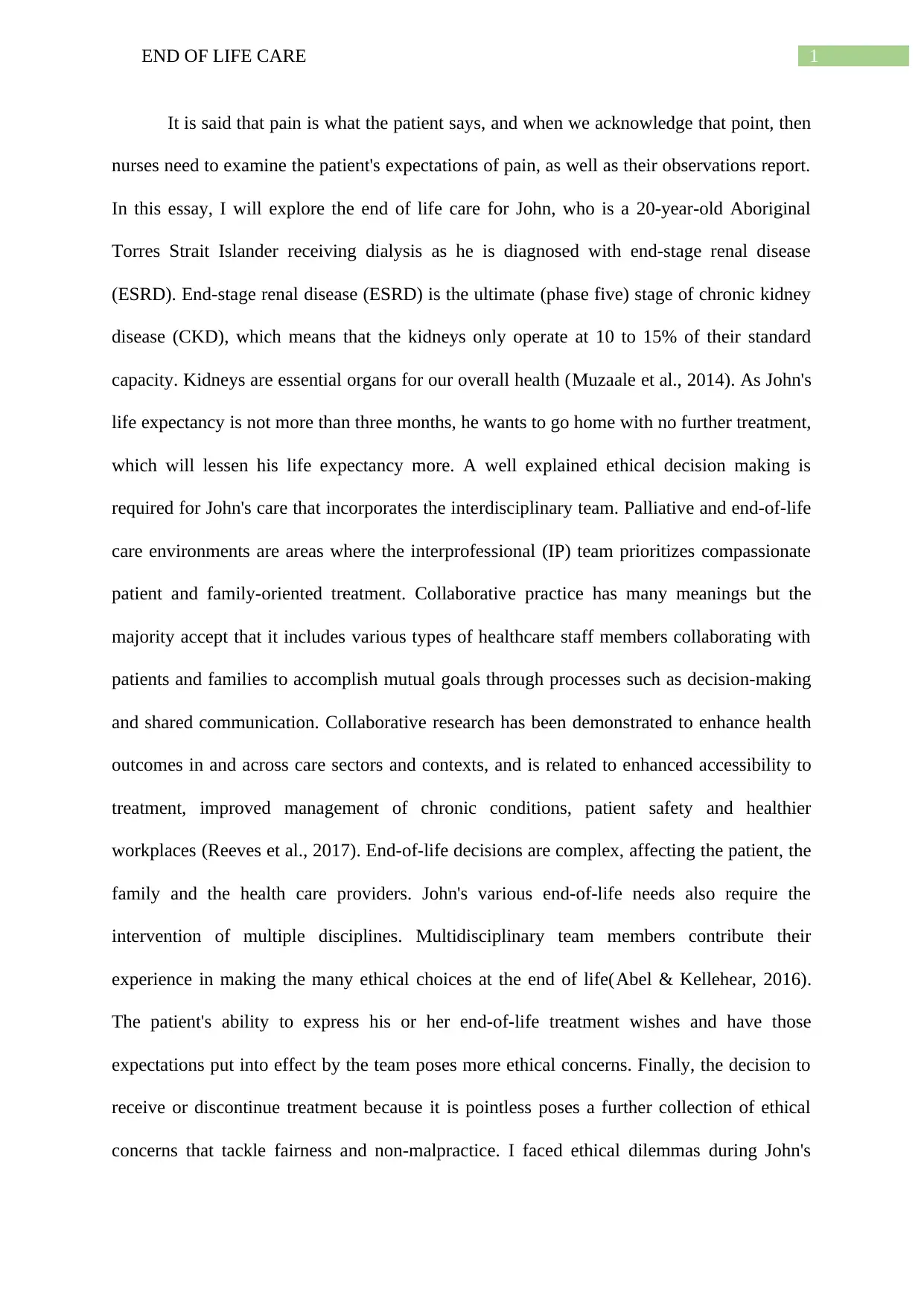
1END OF LIFE CARE
It is said that pain is what the patient says, and when we acknowledge that point, then
nurses need to examine the patient's expectations of pain, as well as their observations report.
In this essay, I will explore the end of life care for John, who is a 20-year-old Aboriginal
Torres Strait Islander receiving dialysis as he is diagnosed with end-stage renal disease
(ESRD). End-stage renal disease (ESRD) is the ultimate (phase five) stage of chronic kidney
disease (CKD), which means that the kidneys only operate at 10 to 15% of their standard
capacity. Kidneys are essential organs for our overall health (Muzaale et al., 2014). As John's
life expectancy is not more than three months, he wants to go home with no further treatment,
which will lessen his life expectancy more. A well explained ethical decision making is
required for John's care that incorporates the interdisciplinary team. Palliative and end-of-life
care environments are areas where the interprofessional (IP) team prioritizes compassionate
patient and family-oriented treatment. Collaborative practice has many meanings but the
majority accept that it includes various types of healthcare staff members collaborating with
patients and families to accomplish mutual goals through processes such as decision-making
and shared communication. Collaborative research has been demonstrated to enhance health
outcomes in and across care sectors and contexts, and is related to enhanced accessibility to
treatment, improved management of chronic conditions, patient safety and healthier
workplaces (Reeves et al., 2017). End-of-life decisions are complex, affecting the patient, the
family and the health care providers. John's various end-of-life needs also require the
intervention of multiple disciplines. Multidisciplinary team members contribute their
experience in making the many ethical choices at the end of life(Abel & Kellehear, 2016).
The patient's ability to express his or her end-of-life treatment wishes and have those
expectations put into effect by the team poses more ethical concerns. Finally, the decision to
receive or discontinue treatment because it is pointless poses a further collection of ethical
concerns that tackle fairness and non-malpractice. I faced ethical dilemmas during John's
It is said that pain is what the patient says, and when we acknowledge that point, then
nurses need to examine the patient's expectations of pain, as well as their observations report.
In this essay, I will explore the end of life care for John, who is a 20-year-old Aboriginal
Torres Strait Islander receiving dialysis as he is diagnosed with end-stage renal disease
(ESRD). End-stage renal disease (ESRD) is the ultimate (phase five) stage of chronic kidney
disease (CKD), which means that the kidneys only operate at 10 to 15% of their standard
capacity. Kidneys are essential organs for our overall health (Muzaale et al., 2014). As John's
life expectancy is not more than three months, he wants to go home with no further treatment,
which will lessen his life expectancy more. A well explained ethical decision making is
required for John's care that incorporates the interdisciplinary team. Palliative and end-of-life
care environments are areas where the interprofessional (IP) team prioritizes compassionate
patient and family-oriented treatment. Collaborative practice has many meanings but the
majority accept that it includes various types of healthcare staff members collaborating with
patients and families to accomplish mutual goals through processes such as decision-making
and shared communication. Collaborative research has been demonstrated to enhance health
outcomes in and across care sectors and contexts, and is related to enhanced accessibility to
treatment, improved management of chronic conditions, patient safety and healthier
workplaces (Reeves et al., 2017). End-of-life decisions are complex, affecting the patient, the
family and the health care providers. John's various end-of-life needs also require the
intervention of multiple disciplines. Multidisciplinary team members contribute their
experience in making the many ethical choices at the end of life(Abel & Kellehear, 2016).
The patient's ability to express his or her end-of-life treatment wishes and have those
expectations put into effect by the team poses more ethical concerns. Finally, the decision to
receive or discontinue treatment because it is pointless poses a further collection of ethical
concerns that tackle fairness and non-malpractice. I faced ethical dilemmas during John's
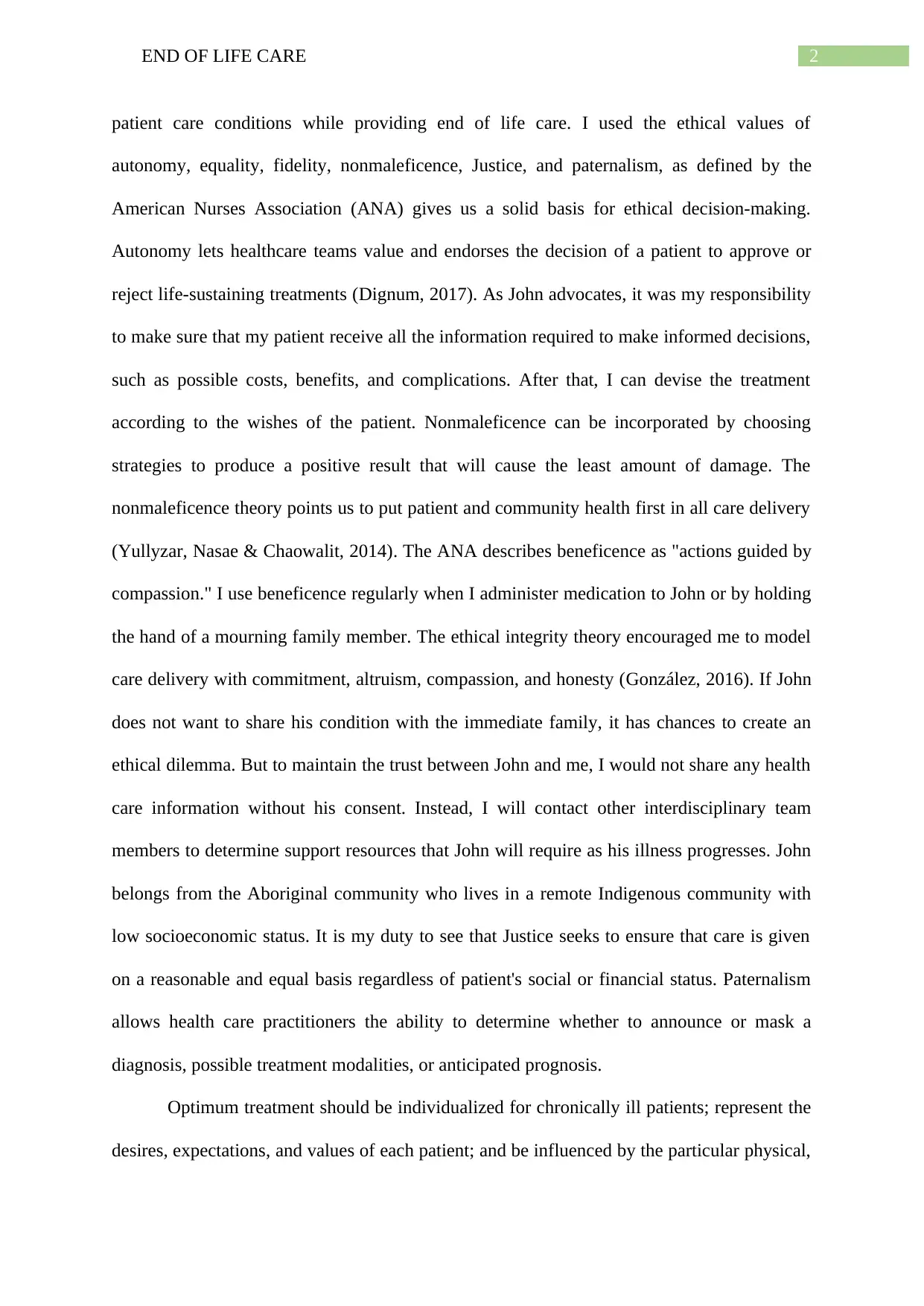
2END OF LIFE CARE
patient care conditions while providing end of life care. I used the ethical values of
autonomy, equality, fidelity, nonmaleficence, Justice, and paternalism, as defined by the
American Nurses Association (ANA) gives us a solid basis for ethical decision-making.
Autonomy lets healthcare teams value and endorses the decision of a patient to approve or
reject life-sustaining treatments (Dignum, 2017). As John advocates, it was my responsibility
to make sure that my patient receive all the information required to make informed decisions,
such as possible costs, benefits, and complications. After that, I can devise the treatment
according to the wishes of the patient. Nonmaleficence can be incorporated by choosing
strategies to produce a positive result that will cause the least amount of damage. The
nonmaleficence theory points us to put patient and community health first in all care delivery
(Yullyzar, Nasae & Chaowalit, 2014). The ANA describes beneficence as "actions guided by
compassion." I use beneficence regularly when I administer medication to John or by holding
the hand of a mourning family member. The ethical integrity theory encouraged me to model
care delivery with commitment, altruism, compassion, and honesty (González, 2016). If John
does not want to share his condition with the immediate family, it has chances to create an
ethical dilemma. But to maintain the trust between John and me, I would not share any health
care information without his consent. Instead, I will contact other interdisciplinary team
members to determine support resources that John will require as his illness progresses. John
belongs from the Aboriginal community who lives in a remote Indigenous community with
low socioeconomic status. It is my duty to see that Justice seeks to ensure that care is given
on a reasonable and equal basis regardless of patient's social or financial status. Paternalism
allows health care practitioners the ability to determine whether to announce or mask a
diagnosis, possible treatment modalities, or anticipated prognosis.
Optimum treatment should be individualized for chronically ill patients; represent the
desires, expectations, and values of each patient; and be influenced by the particular physical,
patient care conditions while providing end of life care. I used the ethical values of
autonomy, equality, fidelity, nonmaleficence, Justice, and paternalism, as defined by the
American Nurses Association (ANA) gives us a solid basis for ethical decision-making.
Autonomy lets healthcare teams value and endorses the decision of a patient to approve or
reject life-sustaining treatments (Dignum, 2017). As John advocates, it was my responsibility
to make sure that my patient receive all the information required to make informed decisions,
such as possible costs, benefits, and complications. After that, I can devise the treatment
according to the wishes of the patient. Nonmaleficence can be incorporated by choosing
strategies to produce a positive result that will cause the least amount of damage. The
nonmaleficence theory points us to put patient and community health first in all care delivery
(Yullyzar, Nasae & Chaowalit, 2014). The ANA describes beneficence as "actions guided by
compassion." I use beneficence regularly when I administer medication to John or by holding
the hand of a mourning family member. The ethical integrity theory encouraged me to model
care delivery with commitment, altruism, compassion, and honesty (González, 2016). If John
does not want to share his condition with the immediate family, it has chances to create an
ethical dilemma. But to maintain the trust between John and me, I would not share any health
care information without his consent. Instead, I will contact other interdisciplinary team
members to determine support resources that John will require as his illness progresses. John
belongs from the Aboriginal community who lives in a remote Indigenous community with
low socioeconomic status. It is my duty to see that Justice seeks to ensure that care is given
on a reasonable and equal basis regardless of patient's social or financial status. Paternalism
allows health care practitioners the ability to determine whether to announce or mask a
diagnosis, possible treatment modalities, or anticipated prognosis.
Optimum treatment should be individualized for chronically ill patients; represent the
desires, expectations, and values of each patient; and be influenced by the particular physical,
⊘ This is a preview!⊘
Do you want full access?
Subscribe today to unlock all pages.

Trusted by 1+ million students worldwide
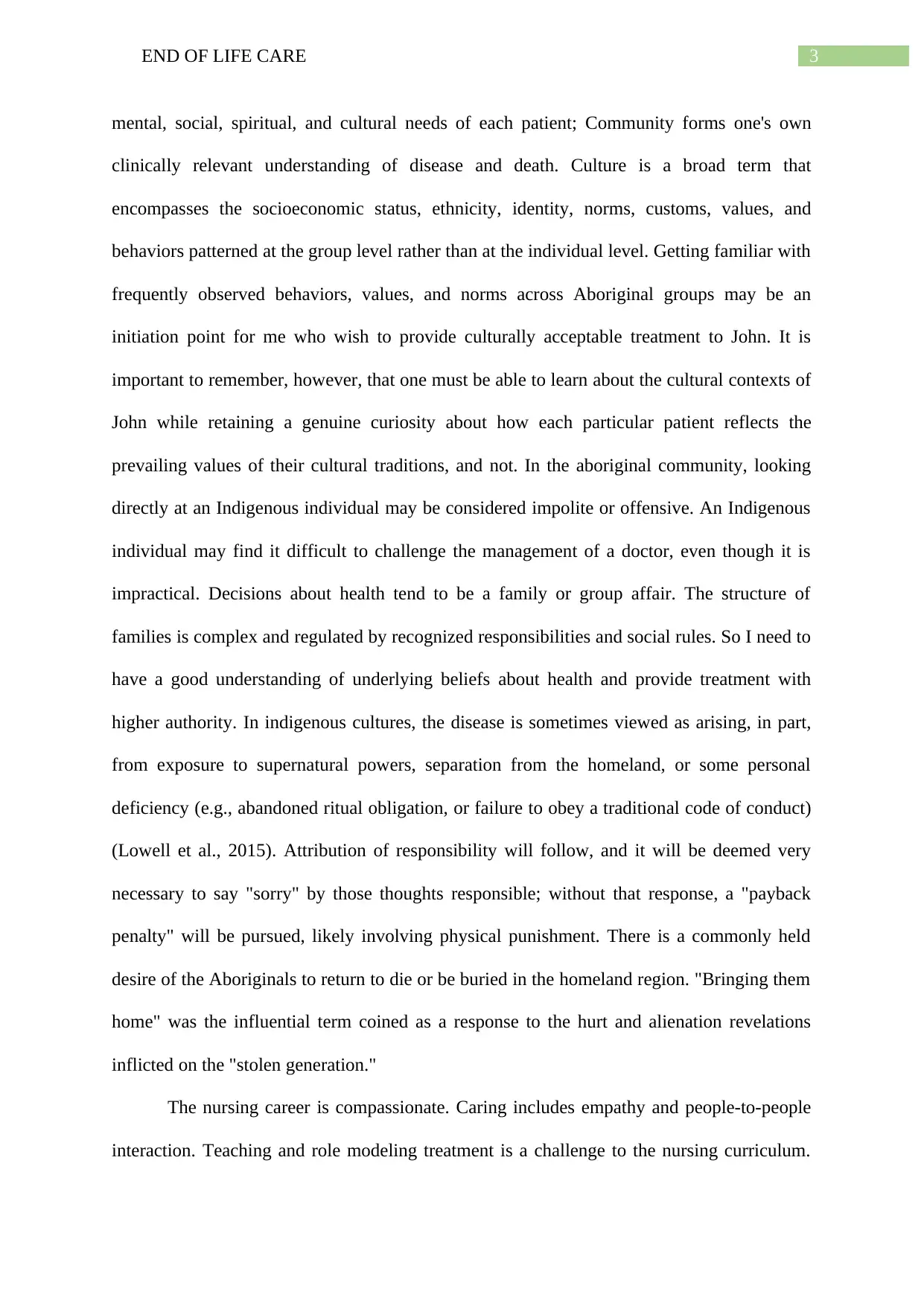
3END OF LIFE CARE
mental, social, spiritual, and cultural needs of each patient; Community forms one's own
clinically relevant understanding of disease and death. Culture is a broad term that
encompasses the socioeconomic status, ethnicity, identity, norms, customs, values, and
behaviors patterned at the group level rather than at the individual level. Getting familiar with
frequently observed behaviors, values, and norms across Aboriginal groups may be an
initiation point for me who wish to provide culturally acceptable treatment to John. It is
important to remember, however, that one must be able to learn about the cultural contexts of
John while retaining a genuine curiosity about how each particular patient reflects the
prevailing values of their cultural traditions, and not. In the aboriginal community, looking
directly at an Indigenous individual may be considered impolite or offensive. An Indigenous
individual may find it difficult to challenge the management of a doctor, even though it is
impractical. Decisions about health tend to be a family or group affair. The structure of
families is complex and regulated by recognized responsibilities and social rules. So I need to
have a good understanding of underlying beliefs about health and provide treatment with
higher authority. In indigenous cultures, the disease is sometimes viewed as arising, in part,
from exposure to supernatural powers, separation from the homeland, or some personal
deficiency (e.g., abandoned ritual obligation, or failure to obey a traditional code of conduct)
(Lowell et al., 2015). Attribution of responsibility will follow, and it will be deemed very
necessary to say "sorry" by those thoughts responsible; without that response, a "payback
penalty" will be pursued, likely involving physical punishment. There is a commonly held
desire of the Aboriginals to return to die or be buried in the homeland region. "Bringing them
home" was the influential term coined as a response to the hurt and alienation revelations
inflicted on the "stolen generation."
The nursing career is compassionate. Caring includes empathy and people-to-people
interaction. Teaching and role modeling treatment is a challenge to the nursing curriculum.
mental, social, spiritual, and cultural needs of each patient; Community forms one's own
clinically relevant understanding of disease and death. Culture is a broad term that
encompasses the socioeconomic status, ethnicity, identity, norms, customs, values, and
behaviors patterned at the group level rather than at the individual level. Getting familiar with
frequently observed behaviors, values, and norms across Aboriginal groups may be an
initiation point for me who wish to provide culturally acceptable treatment to John. It is
important to remember, however, that one must be able to learn about the cultural contexts of
John while retaining a genuine curiosity about how each particular patient reflects the
prevailing values of their cultural traditions, and not. In the aboriginal community, looking
directly at an Indigenous individual may be considered impolite or offensive. An Indigenous
individual may find it difficult to challenge the management of a doctor, even though it is
impractical. Decisions about health tend to be a family or group affair. The structure of
families is complex and regulated by recognized responsibilities and social rules. So I need to
have a good understanding of underlying beliefs about health and provide treatment with
higher authority. In indigenous cultures, the disease is sometimes viewed as arising, in part,
from exposure to supernatural powers, separation from the homeland, or some personal
deficiency (e.g., abandoned ritual obligation, or failure to obey a traditional code of conduct)
(Lowell et al., 2015). Attribution of responsibility will follow, and it will be deemed very
necessary to say "sorry" by those thoughts responsible; without that response, a "payback
penalty" will be pursued, likely involving physical punishment. There is a commonly held
desire of the Aboriginals to return to die or be buried in the homeland region. "Bringing them
home" was the influential term coined as a response to the hurt and alienation revelations
inflicted on the "stolen generation."
The nursing career is compassionate. Caring includes empathy and people-to-people
interaction. Teaching and role modeling treatment is a challenge to the nursing curriculum.
Paraphrase This Document
Need a fresh take? Get an instant paraphrase of this document with our AI Paraphraser
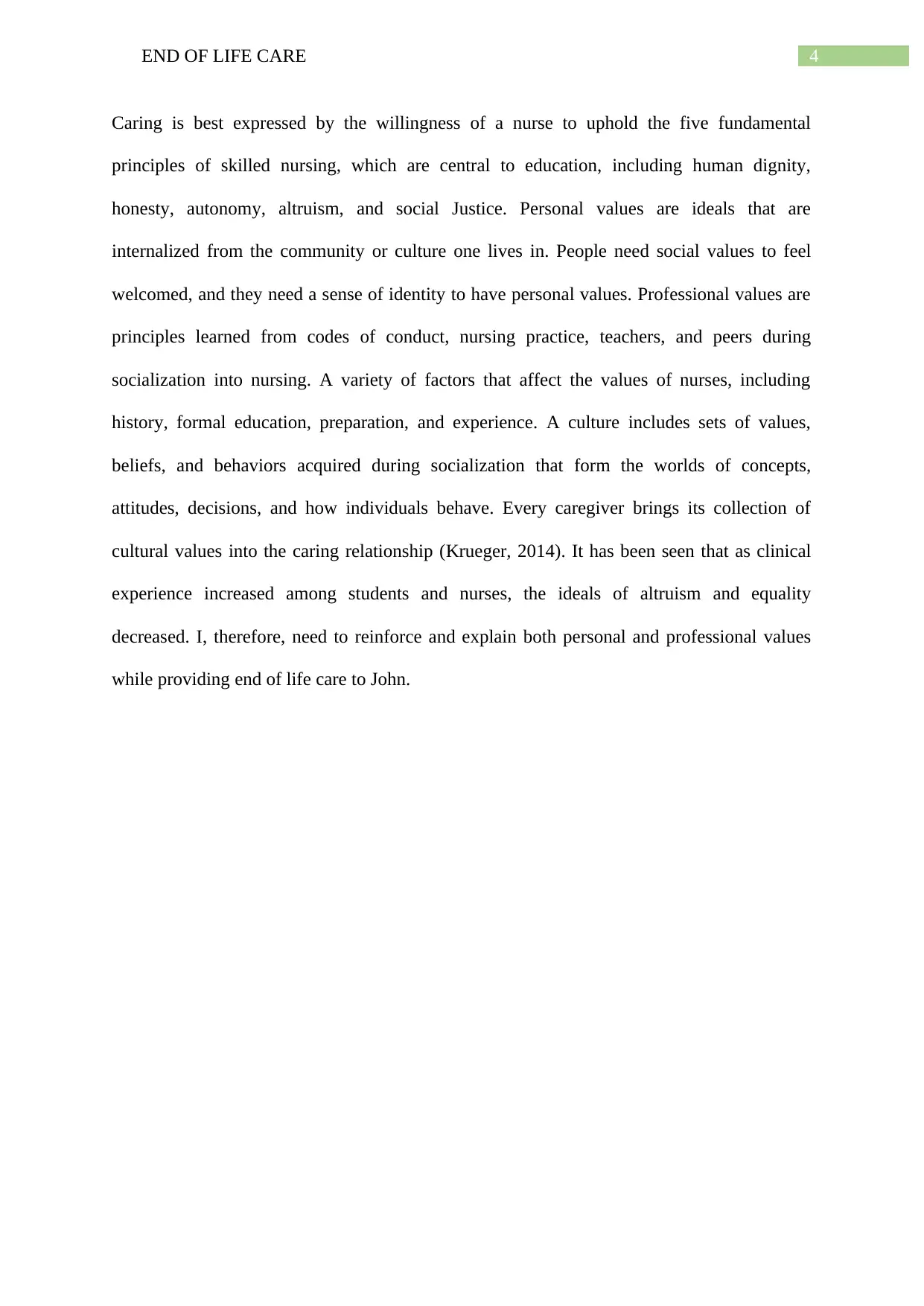
4END OF LIFE CARE
Caring is best expressed by the willingness of a nurse to uphold the five fundamental
principles of skilled nursing, which are central to education, including human dignity,
honesty, autonomy, altruism, and social Justice. Personal values are ideals that are
internalized from the community or culture one lives in. People need social values to feel
welcomed, and they need a sense of identity to have personal values. Professional values are
principles learned from codes of conduct, nursing practice, teachers, and peers during
socialization into nursing. A variety of factors that affect the values of nurses, including
history, formal education, preparation, and experience. A culture includes sets of values,
beliefs, and behaviors acquired during socialization that form the worlds of concepts,
attitudes, decisions, and how individuals behave. Every caregiver brings its collection of
cultural values into the caring relationship (Krueger, 2014). It has been seen that as clinical
experience increased among students and nurses, the ideals of altruism and equality
decreased. I, therefore, need to reinforce and explain both personal and professional values
while providing end of life care to John.
Caring is best expressed by the willingness of a nurse to uphold the five fundamental
principles of skilled nursing, which are central to education, including human dignity,
honesty, autonomy, altruism, and social Justice. Personal values are ideals that are
internalized from the community or culture one lives in. People need social values to feel
welcomed, and they need a sense of identity to have personal values. Professional values are
principles learned from codes of conduct, nursing practice, teachers, and peers during
socialization into nursing. A variety of factors that affect the values of nurses, including
history, formal education, preparation, and experience. A culture includes sets of values,
beliefs, and behaviors acquired during socialization that form the worlds of concepts,
attitudes, decisions, and how individuals behave. Every caregiver brings its collection of
cultural values into the caring relationship (Krueger, 2014). It has been seen that as clinical
experience increased among students and nurses, the ideals of altruism and equality
decreased. I, therefore, need to reinforce and explain both personal and professional values
while providing end of life care to John.
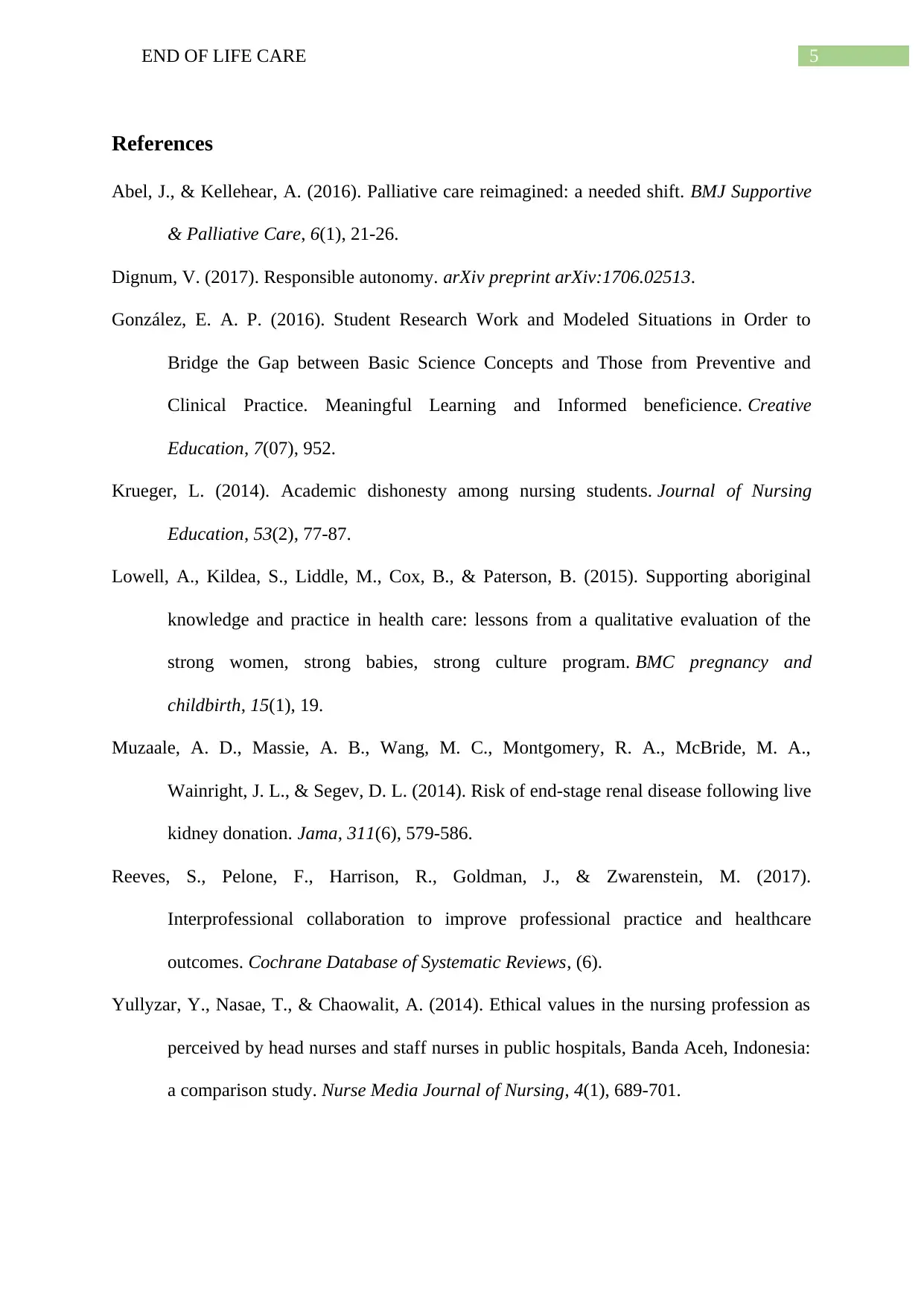
5END OF LIFE CARE
References
Abel, J., & Kellehear, A. (2016). Palliative care reimagined: a needed shift. BMJ Supportive
& Palliative Care, 6(1), 21-26.
Dignum, V. (2017). Responsible autonomy. arXiv preprint arXiv:1706.02513.
González, E. A. P. (2016). Student Research Work and Modeled Situations in Order to
Bridge the Gap between Basic Science Concepts and Those from Preventive and
Clinical Practice. Meaningful Learning and Informed beneficience. Creative
Education, 7(07), 952.
Krueger, L. (2014). Academic dishonesty among nursing students. Journal of Nursing
Education, 53(2), 77-87.
Lowell, A., Kildea, S., Liddle, M., Cox, B., & Paterson, B. (2015). Supporting aboriginal
knowledge and practice in health care: lessons from a qualitative evaluation of the
strong women, strong babies, strong culture program. BMC pregnancy and
childbirth, 15(1), 19.
Muzaale, A. D., Massie, A. B., Wang, M. C., Montgomery, R. A., McBride, M. A.,
Wainright, J. L., & Segev, D. L. (2014). Risk of end-stage renal disease following live
kidney donation. Jama, 311(6), 579-586.
Reeves, S., Pelone, F., Harrison, R., Goldman, J., & Zwarenstein, M. (2017).
Interprofessional collaboration to improve professional practice and healthcare
outcomes. Cochrane Database of Systematic Reviews, (6).
Yullyzar, Y., Nasae, T., & Chaowalit, A. (2014). Ethical values in the nursing profession as
perceived by head nurses and staff nurses in public hospitals, Banda Aceh, Indonesia:
a comparison study. Nurse Media Journal of Nursing, 4(1), 689-701.
References
Abel, J., & Kellehear, A. (2016). Palliative care reimagined: a needed shift. BMJ Supportive
& Palliative Care, 6(1), 21-26.
Dignum, V. (2017). Responsible autonomy. arXiv preprint arXiv:1706.02513.
González, E. A. P. (2016). Student Research Work and Modeled Situations in Order to
Bridge the Gap between Basic Science Concepts and Those from Preventive and
Clinical Practice. Meaningful Learning and Informed beneficience. Creative
Education, 7(07), 952.
Krueger, L. (2014). Academic dishonesty among nursing students. Journal of Nursing
Education, 53(2), 77-87.
Lowell, A., Kildea, S., Liddle, M., Cox, B., & Paterson, B. (2015). Supporting aboriginal
knowledge and practice in health care: lessons from a qualitative evaluation of the
strong women, strong babies, strong culture program. BMC pregnancy and
childbirth, 15(1), 19.
Muzaale, A. D., Massie, A. B., Wang, M. C., Montgomery, R. A., McBride, M. A.,
Wainright, J. L., & Segev, D. L. (2014). Risk of end-stage renal disease following live
kidney donation. Jama, 311(6), 579-586.
Reeves, S., Pelone, F., Harrison, R., Goldman, J., & Zwarenstein, M. (2017).
Interprofessional collaboration to improve professional practice and healthcare
outcomes. Cochrane Database of Systematic Reviews, (6).
Yullyzar, Y., Nasae, T., & Chaowalit, A. (2014). Ethical values in the nursing profession as
perceived by head nurses and staff nurses in public hospitals, Banda Aceh, Indonesia:
a comparison study. Nurse Media Journal of Nursing, 4(1), 689-701.
⊘ This is a preview!⊘
Do you want full access?
Subscribe today to unlock all pages.

Trusted by 1+ million students worldwide
1 out of 6
Related Documents
Your All-in-One AI-Powered Toolkit for Academic Success.
+13062052269
info@desklib.com
Available 24*7 on WhatsApp / Email
![[object Object]](/_next/static/media/star-bottom.7253800d.svg)
Unlock your academic potential
Copyright © 2020–2025 A2Z Services. All Rights Reserved. Developed and managed by ZUCOL.





